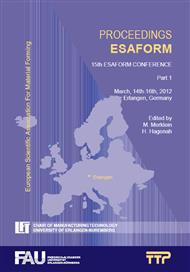p.143
p.151
p.157
p.163
p.169
p.175
p.181
p.187
p.193
Microstructural Behaviour in Rotary Forging of Inconel 718
Abstract:
In the work developed in this paper, the model of the microstructural behavior of Inconel 718 for the rotary forging process is studied. This process is presented as an alternative to the conventional forging. The window process of Inconel 718 is very narrow, so the requirements for manufacturing Inconel are very restrictive. Optimization of the rotary forging process was carried out in order to manufacture Inconel pieces with good microstructural distribution. Microstructural specification was given by aeronautic sector. Numerical work was done in order to simulate the microstructural behavior during the forming process. This method was used: a) to understand the recrystallization mechanism that take place in rotary forging processes, b) to compare the microstructure between a piece done in conventional forging and another done in rotary forging and c) to study the influence of the initial grain size in the final piece.
Info:
Periodical:
Pages:
169-174
Citation:
Online since:
February 2012
Authors:
Keywords:
Price:
Сopyright:
© 2012 Trans Tech Publications Ltd. All Rights Reserved
Share:
Citation:


